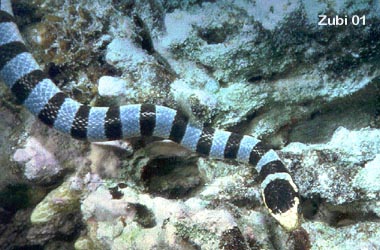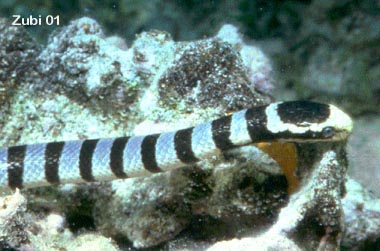
(Laticauda colubrina)


This photo was taken from 20 cm away. Although seasnakes are highly venomous, they are not aggressive. They are seldom encountered by divers, but sometimes they can be seen swimming to the surface to gulp air (they are airbreathing like us). I was able to observe this banded sea krait for nearly 10 minutes in shallow water. while it was probing crevices and holes in search of small fish. This snake was rather small (under 1m) but sea snakes can grow to about 2 meter.
The Banded (or Yellow lipped) Sea Krait is one of the most common sea snakes in South East Asia and easily recognized by ist distinctive dark and white rings and the yellow lips. Lauticauda laticaudata looks very similar but has a bluish color.
This sea snakes normally hunts among coral crevices down to about 20 meters for morey eels. The sea snakes bites the morey just once and envenomates it. The morey retreats to its lair and the snakes waits until it dies (that takes about 8 to 16 minutes) and then flushes it out and swallows it underwater, head first. The Sea Krait prefers warm water, but it can dive up to 60m deep and has been found foraging over 7km away from the nearest land!
The Banded (or Yellow lipped) Sea Krait is amphibious and leaves the water to digest its prey inshore and to lay eggs on the beach. It has also been observed to climb up trees. Sea Kraits have been observed mating in the water but also on land. However the eggs are always laid in a clutch of 4 to 20 eggs in crevices on land. Hatchlings are about 29cm long and hatch after an incubation time of about 4 months. It can be up to 1.4 meters long.
There are some eels, especially snake eels that are frequently confused with snakes. Look at the following photo below and it easily understood why.

Not only are the patterns very similar, but the snake eel also moves like a snake. However on close inspection it is easy to tell them apart. Sea snakes have scales and no fins on their back. Snake eels have a gill opening behind their head and large nostrils. The Snake eel mimics the sea snake, because this gives them some protection against predators.
Snake on Cabilao island, Bohol, Philippines March 2001 / Snake Eel: Lembeh, , Indonesia 2005
Sea and Sea Motomarine II EX / Nikon Coolpix 5000 in sealux housing and subtronic flash
![]()
. Copyright Teresa Zubi